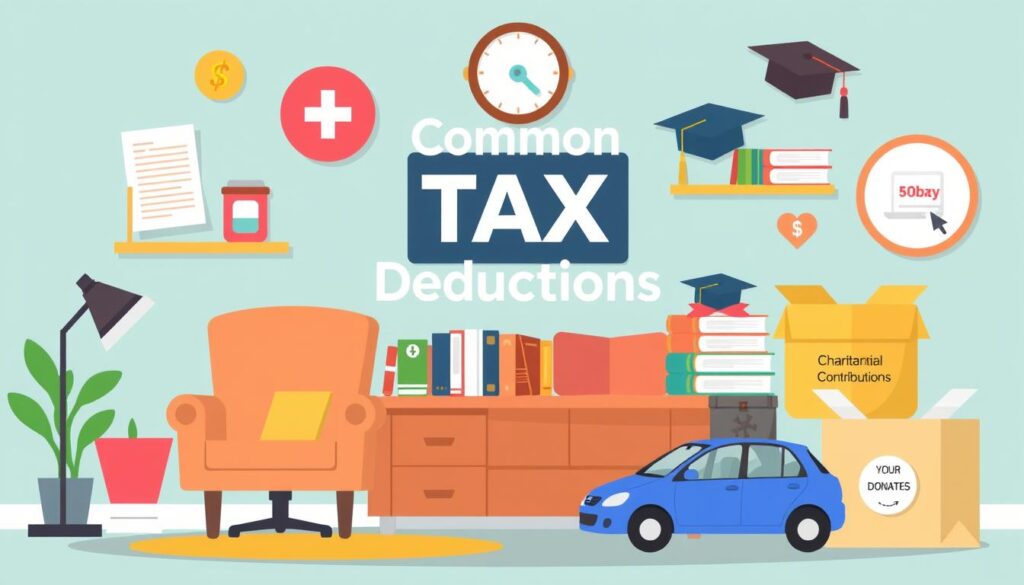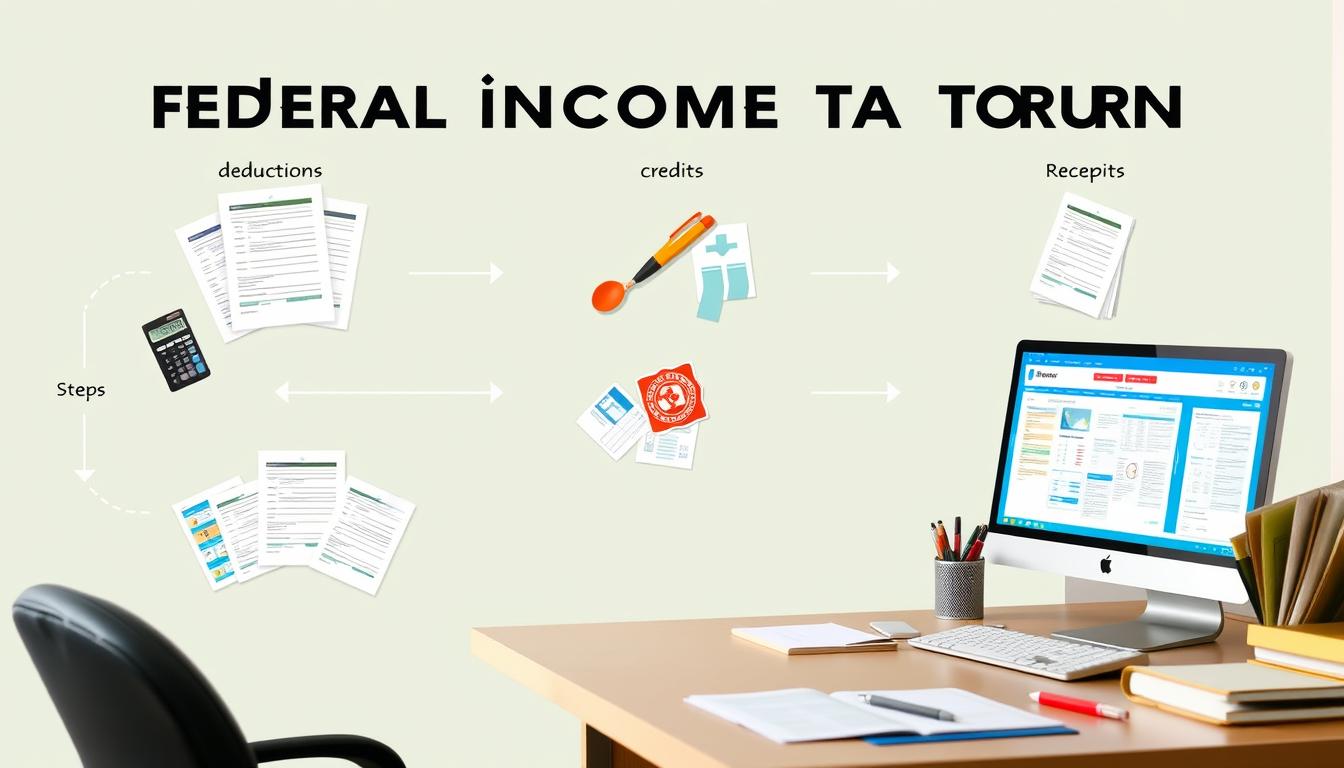As the tax season approaches, you may find yourself feeling overwhelmed by the sheer volume of paperwork and numbers that seem to pop up every year. It’s a routine that many dread, yet it’s also an opportunity. Maximizing your savings on your tax return can transform how you view your hard-earned income. Instead of seeing your tax return as just another chore, imagine it as a chance to secure your financial future. Strategies for effective tax preparation can empower you to claim every possible income tax refund, allowing you to breathe easier knowing that you’re keeping more of what you earn. This guide aims to serve as your roadmap, providing clarity on necessary tax deductions and credits that can help you achieve your financial goals. Let’s embrace this chance to take control of your finances1.
Key Takeaways
- Understanding your tax return is crucial for maximizing your savings.
- Claiming all eligible tax deductions can significantly increase your income tax refund.
- Planning ahead and staying organized simplifies the tax preparation process.
- Leveraging tax credits, like the Earned Income Tax Credit, can further boost your refund.
- Awareness of changes in tax laws can impact your overall tax strategy.
Understanding Your Tax Return
Understanding what is a tax return is essential for every taxpayer. This document consists of detailed information regarding your income, expenses, and withheld taxes. It serves to calculate your tax liability, indicating whether you owe money or qualify for an income tax refund. The federal income tax returns typically are due mid-April2. Knowing how to handle your tax filing correctly can save you from unnecessary penalties, such as failing to file or pay your taxes on time.
What is a Tax Return?
A tax return is a critical component of your financial responsibilities. This document includes forms and schedules that report various income sources, including salaries, dividends, or interest earned. In addition, it allows you to declare deductions and credits. Approximately only 10% of taxpayers currently itemize deductions, opting instead for the standard deduction, making tax filing more streamlined3. Furthermore, different forms exist for specific needs, including Forms 1040 and 1040-SR for the 2023 tax season3.
Why is Filing Important?
The filing importance cannot be overstated. Completing your tax return not only permits you to settle any taxes owed but also gives you access to potential tax credits that directly decrease your tax bill. For example, common tax credits include the earned income tax credit and the child tax credit2. Keeping your tax paperwork for at least three years is generally recommended, allowing you to stay prepared for possible audits or inquiries from the IRS2. Properly filed tax documents enable you to take full advantage of all available deductions and credits, optimizing your overall financial situation.

Key Tax Terms You Should Know
Understanding essential tax terms unlocks better financial planning and maximizes your savings when filing taxes. Familiarity with the differences between tax deductions and tax credits enables you to make informed decisions that can significantly impact your adjusted gross income and tax refund.
Deductions vs. Credits
Tax deductions lower your taxable income, which can reduce the overall amount of taxes you owe. In contrast, tax credits provide a direct reduction in your tax liability, effectively lowering the amount you owe to the IRS. Knowing when to utilize deductions and credits can make a notable difference in your overall tax outcome. TurboTax experts emphasize the importance of knowing and utilizing available tax deductions and credits to impact tax liabilities and maximize refunds4.
Adjusted Gross Income (AGI)
Your adjusted gross income is calculated by taking your gross income and subtracting specific deductions, such as IRA contributions and certain business expenses. It serves as a critical figure that helps determine your eligibility for various tax credits and deductions. For example, the amount of income tax credits you may qualify for is often based on your AGI, making it essential to keep your deductions up-to-date5.
Standard Deduction vs. Itemizing
When preparing your tax return, you typically face the choice of claiming the standard deduction or itemizing your tax deductions. The standard deduction offers a flat reduction based on your filing status, while itemizing allows you to list qualifying expenses, such as mortgage interest or charitable donations. Evaluating which option provides the greater benefit is crucial, especially considering changes in tax laws where certain exemptions may no longer apply4. Below is a comparative table that outlines key aspects of both methods:
| Feature | Standard Deduction | Itemized Deductions |
|---|---|---|
| Ease of Use | Simple, requires minimal documentation | Requires detailed record-keeping |
| Maximum Amount | Varies by filing status | Based on actual expenses incurred |
| Potential Benefit | Provides a quick tax relief | Can provide larger deductions with significant expenses |
| Applicable Situations | Best for straightforward situations | Beneficial for taxpayers with numerous deductible expenses |

Getting Organized Before Filing
Before you embark on the journey to file taxes, getting organized is an essential first step. Gathering all necessary documents is crucial for effective tax preparation. You will need Form W-2 for your employment income, Form 1099 if you earned income through freelance or contract work, and any other pertinent forms such as Form 1095-A for health insurance coverage and Form 1098-T if you paid college tuition in 20166. Don’t forget to include documentation like the Mortgage Interest Statement and records of Property Tax Payments if applicable6.
Gather Necessary Documents
Collecting the right paperwork is vital. Make sure to gather the forms mentioned above and any supporting documents that verify your expenses and income. You should also have previous tax returns from 2015 and 2014 on hand, as they may be necessary when completing your current tax return6.
Create a Filing System
Next, implement an organized filing system for these documents. This can be done using physical folders or digital storage solutions. Grouping your materials in an orderly fashion allows for quick and easy access when you’re ready to start on your tax preparation. An organized approach minimizes stress as you prepare to file taxes.
Use Tax Preparation Software
Utilizing tax preparation software is a smart way to simplify the process. Many of these programs can help automate calculations, guide you through potential deductions, and ensure you have all necessary documentation. By streamlining the process with technology, it becomes easier to manage your filing system and stay organized7. Don’t forget that the IRS offers free filing tools that can assist you if you’re comfortable navigating tax forms online7.

Common Tax Deductions You May Qualify For
Understanding the various common tax deductions can greatly enhance your tax return. Each deduction has unique eligibility requirements, yet they all help in making your tax liabilities lighter. Here are three common areas where you might find significant savings:
Mortgage Interest Deduction
The mortgage interest deduction allows homeowners to deduct interest paid on their mortgage, significantly reducing taxable income. This deduction is particularly beneficial for those making substantial home payments throughout the year. You’ll need to gather your Form 1098 from your lender to complete this deduction properly as it specifies the amount of interest paid.
Student Loan Interest Deduction
Many graduates overlook the student loan interest deduction, which allows you to write off up to $2,500 of interest paid on student loans during the year. This deduction can ease the financial burden, especially for recent graduates beginning their careers8. Be sure to check the eligibility requirements to ensure you qualify.
Medical Expenses Deduction
You can deduct unreimbursed medical expenses that surpass 7.5% of your Adjusted Gross Income (AGI). This means if your medical expenses are significant, you might be able to reduce your taxable income accordingly9. It’s important to keep detailed records of all medical expenses to claim this deduction accurately.

The rules around common tax deductions can evolve, so it is wise to stay informed.
Be proactive in gathering documentation for these common tax deductions this tax season to maximize your benefits and potentially secure a larger refund10.
Tax Credits: A Smart Way to Save
Tax credits play a crucial role in reducing your overall tax burden, allowing you to save significantly. By understanding the various credits available, you can maximize your savings come tax season. Notably, there are two primary types of tax credits: refundable and nonrefundable. Refundable tax credits, such as the Earned Income Tax Credit (EITC), can result in a tax refund even if your tax liability is zero11. Nonrefundable credits, on the other hand, can only reduce your tax liability to zero, meaning if your credits exceed your taxes owed, you won’t receive the difference back.
Earned Income Tax Credit (EITC)
The Earned Income Tax Credit is particularly beneficial for low-to-moderate-income families. In 2024, those who qualify may receive a credit of up to $7,830, potentially boosting your tax refund significantly12. Unfortunately, millions of eligible workers do not claim this valuable credit each year, missing out on potential savings that could total thousands of dollars13.
Child Tax Credit
The Child Tax Credit allows parents to reclaim up to $2,000 per qualifying child under age 1713. For the 2024 tax year, this amount includes a refundable portion that could be as much as $1,70012. It’s vital that each child meets certain requirements, such as being a U.S. citizen and having a valid Social Security number.
Education Tax Credits
Education tax credits, such as the American Opportunity Credit, provide significant financial relief for students. This credit allows for a maximum benefit of $2,500 per eligible student13. In addition, the Lifetime Learning Credit offers up to $2,000 per tax return for non-degree courses and education-related expenses12. Exploring these credits can substantially alleviate the financial burden of education while enhancing your overall return.

Filing Options: Which One is Right for You?
When it comes to filing your taxes, you have several options. Understanding these choices can help you determine the best approach for your situation, whether you’re considering DIY tax filing, opting for professional tax preparation, or using online tax services.
DIY Filing
DIY tax filing can be a budget-friendly option, particularly if your tax situation is straightforward. Many individuals find success using tax preparation software that guides them through the process. If your adjusted gross income is $79,000 or less, you can electronically file taxes for free using the IRS Free File option14. Additionally, for those earning $64,000 or less, free tax prep help is also available through IRS-certified volunteers15. These resources can simplify the process and help ensure you take advantage of all possible deductions.
Professional Tax Preparation
Hiring professionals for tax preparation offers a safety net, especially for complicated situations. They can navigate the intricacies of tax code and help maximize your refund. Individuals stationed abroad or in combat zones may even qualify for extended filing deadlines, adding another layer of convenience when using professional services14. Having an expert review your situation may provide peace of mind in ensuring accuracy and compliance.
Online Tax Services
The rise of online tax services provides a hybrid approach that combines the convenience of DIY filing with guidance from professionals. Online platforms often offer step-by-step instructions while allowing you to file your taxes efficiently from home. This method is beneficial for those who want to file taxes without the expense of hiring an expert, while still having access to helpful resources. In fact, around 100 million people are eligible to file tax returns for free, making online options accessible to a significant portion of the population15.

| Filing Option | Cost | Best For |
|---|---|---|
| DIY Tax Filing | Free to Low Cost | Simple Tax Situations |
| Professional Tax Preparation | Higher Cost | Complex Returns |
| Online Tax Services | Varies (often free options) | Guided DIY Experience |
Understanding Tax Brackets and Rates
Tax brackets and income tax rates play a crucial role in determining how much you owe in taxes. Understanding these concepts can help you make informed decisions regarding your financial strategies. The U.S. federal income tax system operates on a progressive model, impacting how much you pay as your income changes.
How are Tax Brackets Structured?
For the tax years 2023 and 2024, there are seven federal income tax brackets ranging from 10% to 37%16. Tax brackets are designed to apply different rates to various portions of taxable income, allowing tax rates to increase as your earnings grow16. As of 2024, the tax brackets for Single filers, Married Filing Jointly, Married Filing Separately, and Heads of Household are all identical, with rates set at 10%, 12%, 22%, 24%, 32%, 35%, and 37%16. The IRS adjusts these brackets annually to account for inflation, which can affect which tax bracket you fall into17.
What are Marginal Tax Rates?
The marginal tax rate refers to the tax rate applied to the last dollar of your taxable income. This rate is significant because it helps you understand how additional income or deductions will impact your overall tax liability. For instance, a single filer earning $50,000 in 2025 would see an effective tax rate of approximately 13% due to the bracket structure17. Recognizing marginal tax rates enables better tax planning and the opportunity to optimize deductions, effectively lowering taxable income and potentially reducing taxes owed in higher brackets16.

Changes to Tax Laws You Need to Know
As tax season approaches, staying updated on recent tax law changes is crucial for making informed decisions. Many tax adjustments can significantly alter your financial landscape, impacting your return in various ways. Understanding these updates will empower you and enable you to strategize effectively.
Recent Tax Law Adjustments
For tax year 2025, the standard deduction for single taxpayers rises to $15,000, representing a $400 increase from 202418. Married couples filing jointly will benefit from a standard deduction of $30,000, which is an increase of $800 from the previous year18. Furthermore, the top tax rate remains at 37% for individuals earning over $626,350. Couples jointly filing who exceed $751,600 will also be affected by this top rate18. The Earned Income Tax Credit will see a rise, with the maximum amount reaching $8,046, up from $7,830 in 202418.
Impacts of Legislation on Your Return
As tax laws evolve, various tax adjustments become pertinent. For instance, the adjustments in the tax credits and deductions can directly affect your overall tax burden. Notable changes include the retirement contribution limits being set at $7,000 for an IRA and $23,000 for 401(k)s, with provisions for catch-up contributions19. The estate and gift tax exemption increased to $13,610,000 along with an annual gift exclusion limit of $18,000 per recipient19. It is essential to track these adjustments closely, as they all contribute to the decisive impacts on your return.

Preparing for an IRS Audit
Understanding how to prepare for an IRS audit is vital for every taxpayer. This preparation involves recognizing the potential audit triggers and maintaining robust record keeping. Knowing what could lead to an audit helps you avoid pitfalls in your tax filing process.
What Triggers an Audit?
IRS audits might be initiated based on several audit triggers. Some common triggers include:
- Abnormal income patterns that deviate from your historical earnings.
- High deductions relative to your income, which could raise suspicions.
- Cash businesses often face greater scrutiny due to challenges in accurately proving income.
- Returns with significant discrepancies or errors can easily catch the IRS’s attention.
In the tax year 2016, only 1.1 million out of 196 million returns filed, or 0.5%, were audited by the IRS20. Businesses experience an audit rate of approximately 1-2% annually20. Remember, the IRS can audit any tax return filed within the last three years and can pursue back taxes owed for up to ten years20.
Tips for Keeping Accurate Records
Proper record keeping is crucial for a smooth audit process. Here are some practical tips to enhance your record keeping:
- Maintain organized receipts for all deductions claimed, including business expenses.
- Document explanations for deductions to clarify their legitimacy.
- Utilize accounting software to track income and expenses effectively.
- Retain records for at least seven years, particularly if you have claimed deductions for substantial losses.
Field audits, in particular, assess business records and accounting systems thoroughly, with a keen eye on expenses related to travel, meals, and entertainment20. Having a tax professional present during an audit can expedite the proceedings and help clarify issues as they arise20.

Maintaining accurate and detailed records can save you from potential penalties during an audit20. Remember, audits might conclude with various outcomes, such as no changes, agreed changes, or disagreements based on the findings21. Taxpayers also have rights during the audit process, including the right to appeal any disagreements2120.
Timing is Everything: When to File
Understanding the right timing for your tax filing can significantly influence your overall financial situation. Getting your taxes done early offers numerous advantages such as reducing stress and ensuring you get a refund faster. Maximize your benefits by taking note of key deadlines and strategies for filing.
Best Practices for Filing Early
Filing your taxes early allows you to file early and avoid the rush that often comes as tax season progresses. This proactive approach significantly decreases the likelihood of errors, which can lead to complications down the line. Remember that the IRS typically mails out W-2 forms by January 31, and businesses are responsible for sending 1099 forms to recipients by the same date. Using these forms promptly can help keep your tax filing timing on track22.
Consider the opportunity to take advantage of available deductions and credits by preparing early. This timing can lead to more substantial savings, as certain tax benefits are available for a limited period. Strategies such as delaying income or making contributions to retirement plans not only optimize your financial planning but also impact your taxable income positively23.
Importance of Deadlines
Adhering to tax deadlines is crucial to avoid penalties associated with late filings. The failure-to-file penalty can accumulate at 5% of the unpaid taxes for each month your return is overdue, with a maximum of 25% of the total taxes owed. Knowledge of these importance of deadlines helps you avoid unnecessary costs and ensures compliance with tax regulations24.
Last-minute filings can lead to rushed decisions, potentially overlooking valuable tax strategies that could save you money. Schedule your key tax dates on a calendar to maintain awareness of your obligations. Remember, timely planning can prevent issues like increased interest on late payments and create opportunities for further tax deductions24.

How to Maximize Your Refund
Strategizing your approach to filing taxes can significantly impact your ability to maximize tax refund. Understanding various refund strategies can lead you to take advantage of deductions, credits, and contributions that can increase the amount you receive back. Taking the time to ensure accurate filing is equally important, as it minimizes mistakes that could reduce your refund or trigger audits.
Strategies to Increase Your Refund
One way to optimize your refund is by claiming all eligible deductions and credits. For the 2022 tax season, the child tax credit provides $2,000 for each qualifying child under 17, while expenses for child and dependent care can be claimed at 20% to 35% of costs up to $6,000 for two or more dependents25. Contributing to retirement accounts, such as an employer-sponsored retirement plan, allows individuals to put away up to $20,500, with an additional catch-up contribution available for those aged 50 or older25. It is also essential to explore health savings account contributions, where individuals can contribute up to $3,650 (or $7,300 for families)25.
Importance of Accuracy in Filing
Accurate filing ensures that all financial details are reported correctly, vital for maximizing your tax refund. Deductible medical and dental expenses only apply if they exceed 7.5% of your adjusted gross income (AGI), emphasizing the necessity of keeping precise records26. Utilizing reliable resources such as the IRS Free File program can make the process easier, providing brand-name software for free27. Engaging a tax professional offers a safety net for skilled tax preparation, helping prevent financial losses that may stem from inadequate filing27. In summary, implementing effective strategies while ensuring accuracy will lead you closer to achieving the maximum refund possible.

Navigating State Taxes
Understanding state taxes is crucial, as they vary significantly from federal taxes. The differences between federal and state taxes can impact your overall tax strategy. Each state governs its tax regulations and offers various benefits, not always aligned with the federal system. Knowing what deductions and credits are available in your state can maximize your savings and possibly increase your refund.
Differences Between State and Federal Taxes
The federal tax system tends to have more consistent regulations applicable across all states. In contrast, your state tax obligations can vary widely, leading to unique situations for each taxpayer. For instance, a taxpayer in California may face different rules compared to someone in Texas regarding state deductions. This variance emphasizes the need to stay informed about both local and federal tax guidelines.
State-Specific Deductions and Credits
Many states offer an array of specific state deductions and credits designed to alleviate the tax burden on residents. Such deductions may include items like local property tax deductions and education credits, which can substantially reduce your taxable income. Additionally, some states implement initiatives to assist taxpayers in navigating their returns, such as the Taxpayer Assistance Program (TAP) provided in New York, facilitating federal and state tax preparation28. In 2024, Free File software could be available for eligible individuals to help streamline this process29.
| State | Common Deductions | Notable Credits |
|---|---|---|
| California | Mortgage interest, state property taxes | Child and dependent care credit |
| New York | Personal exemptions, medical expenses | Empire State child credit |
| Texas | No state income tax | None |

Common Mistakes to Avoid
Being aware of common errors can significantly improve your tax filing experience. Many taxpayers make mistakes that can lead to delays, penalties, or even audits. Recognizing these tax filing mistakes and understanding the importance of accuracy helps ensure a smooth filing process.
Filing Errors
Filing errors are frequent and can encompass a range of issues. One common error is submitting incorrect Social Security numbers, which can delay processing and create complications30. Including math errors is another common mistake. It can arise from simple addition mistakes or more complicated calculations, underscoring the necessity to double-check figures3130. Taxpayers choosing the wrong filing status is frequently reported, yet using tools like the Interactive Tax Assistant can help avoid this pitfall31.
Missing Deadlines
Missing deadlines may result in severe repercussions. Late filings can incur penalties and accumulate interest, exacerbating the situation. The IRS strongly recommends electronic filing and utilizing direct deposit for refunds. This method not only expedites your refund but also mitigates potential common errors resulting from paper submissions30. Ensuring all forms are signed is essential; unsigned forms render a return invalid, leading to unnecessary hassle3130.

| Common Mistakes | Impact | Prevention |
|---|---|---|
| Incorrect Social Security Numbers | Delays in processing and complications with the return | Double-check personal information before submission |
| Math Errors | Potential inaccuracies in tax liability | Use tax software for automatic calculations |
| Unsigned Tax Forms | Return deemed invalid, leading to complications | Verify signatures before submitting |
| Choosing Incorrect Filing Status | Loss of deductions and credits | Utilize tools like the Interactive Tax Assistant |
| Missing Deadlines | Penalties and interest on unpaid taxes | Mark your calendar with significant deadlines |
By taking proactive steps to avoid these common errors, you can streamline your filing process and stay compliant with tax regulations31.
Next Steps After Filing Your Return
After filing taxes, your journey doesn’t end there. You should take immediate steps to track your refund and manage any taxes you may owe. Ensuring that these tasks are completed can help maintain peace of mind and avoid any possible penalties.
Tracking Your Refund
Once you’ve submitted your tax return, it’s crucial to track your refund status. The IRS offers online tools that allow you to monitor your refund’s progress. Generally, you can expect your refund to be processed within 21 days if you filed electronically and chose direct deposit for your refund. Keeping records for three years from the date you filed is advisable in case of any discrepancies32. If any issues arise with your refund, reviewing official IRS correspondence will often clarify the necessary actions to take32.
What to Do if You Owe Taxes
If it turns out that you owe taxes, understanding your payment options promptly can help you avoid additional penalties and interest. Just like with refunds, the IRS won’t reach out via social media or text message, so be cautious of scams32. You typically won’t need to contact the IRS unless you disagree with their information or if they request more details regarding your account32. You can call the IRS customer service at 1-800-829-1040 for questions related to your tax obligation33. Meeting your payment deadline is essential, which for the 2023 tax year is April 15, 202414.

| Scenario | Action Needed |
|---|---|
| Waiting for Refund | Use IRS online tools to check status |
| Refund Issues | Review IRS letter and take necessary actions |
| Owe Taxes | Contact IRS or ensure payment before deadline |
| Payment Deadline | April 15, 2024, for 2023 tax returns |
| IRS Customer Service | Call 1-800-829-1040 |
Taking these next steps can set you on a path to better manage your taxes and your financial future323314.
Conclusion: Take Charge of Your Tax Return
Taking the initiative with your tax return can lead to significant financial advantages. By engaging in proactive tax preparation, you not only better understand the complexities of your taxes but also position yourself for maximized tax return benefits each year. This strategic approach enables you to identify potential savings and optimize your financial outcomes effectively.
Benefits of Proactive Tax Preparation
When you start your focusing on future tax planning today, you can streamline the filing process and minimize errors. Keeping accurate records and staying informed about tax law changes can make a big difference. Additionally, organizing your tax documents and seeking out deductions and credits can substantially boost your refund, ensuring that you benefit fully from your tax situation.
Start Planning for Next Year
Don’t wait until the last minute—begin your preparations today for the upcoming tax season. Gather your paperwork, review your financial situation, and make note of any changes that might affect your return. With the right planning, you can enter each filing season with confidence, transforming what may seem like a chore into a strategic financial opportunity. Remember, your proactive efforts today lay the groundwork for greater tax return benefits in the future3435.
FAQ
What is a tax return?
Why is filing a tax return important?
What’s the difference between tax deductions and tax credits?
How can I maximize my savings on tax returns?
What documents do I need to gather before filing taxes?
What tax software can help me with my filing?
What are some common tax deductions I may qualify for?
How can tax credits help save me money?
What filing options do I have for my taxes?
How are tax brackets structured?
What should I know about recent tax law changes?
What can trigger an IRS audit?
What are the benefits of filing taxes early?
What are some common mistakes to avoid when filing taxes?
How can I track my tax refund status?
What should I do if I owe taxes?
Source Links
- https://turbotax.intuit.com/tax-tips/tax-refund/5-hidden-ways-to-boost-your-tax-refund/L0AZGnJuS – 5 Hidden Ways to Boost Your Tax Refund
- https://www.nerdwallet.com/article/taxes/federal-income-tax-return – Income Tax Return: How It Works, How Long to Keep One – NerdWallet
- https://www.shakespearewm.com/read-tax-return/ – How to Read Your Tax Return
- https://turbotax.intuit.com/tax-tips/tax-planning-and-checklists/8-tax-terms-you-should-know/L6wZxHl0q – Tax Terms You Should Know
- https://apps.irs.gov/app/understandingTaxes/student/glossary.jsp – Understanding Taxes – Glossary
- https://www.accountfully.com/blog/how-to-get-organized-before-filing-taxes-2 – No title found
- https://www.calendar.com/blog/organize-your-way-to-a-smooth-tax-filing-experience/ – Organize Your Way to a Smooth Tax Filing Experience – Calendar
- https://www.irs.gov/credits-and-deductions-for-individuals – Credits and deductions for individuals
- https://www.nerdwallet.com/article/taxes/tax-deductions-tax-breaks – 22 Popular Tax Deductions and Tax Breaks – NerdWallet
- https://www.equifax.com/personal/education/personal-finance/articles/-/learn/popular-tax-credits-and-deductions-2024/ – Tax Deductions & Tax Credits to Know for 2024 | Equifax
- https://www.investopedia.com/terms/t/taxcredit.asp – Tax Credit: What It Is, How It Works, What Qualifies, 3 Types
- https://www.nerdwallet.com/article/taxes/what-tax-credits-can-i-qualify-for – Tax Credits: What They Are, How They Work in 2024-2025 – NerdWallet
- https://www.irs.gov/newsroom/tax-credits-for-individuals-what-they-mean-and-how-they-can-help-refunds – Tax credits for individuals: What they mean and how they can help refunds
- https://www.irs.gov/filing/individuals/how-to-file – File your return | Internal Revenue Service
- https://www.consumerfinance.gov/consumer-tools/guide-to-filing-your-taxes/ – Guide to filing your taxes in 2024 | Consumer Financial Protection Bureau
- https://turbotax.intuit.com/tax-tips/irs-tax-return/what-are-tax-brackets/L8jeM6XaJ – What Are Tax Brackets?
- https://www.investopedia.com/terms/t/taxbracket.asp – 2025 Tax Brackets and Federal Income Tax Rates
- https://www.irs.gov/newsroom/irs-releases-tax-inflation-adjustments-for-tax-year-2025 – IRS releases tax inflation adjustments for tax year 2025
- https://www.schwab.com/learn/story/taxes-things-to-know-now – 2024 Taxes: 8 Things to Know Now
- https://www.bakertilly.com/insights/audit-preparation-5-tips-successful-irs-audit – Audit preparation: 5 tips for a successful IRS audit | Baker Tilly
- https://www.irs.gov/businesses/small-businesses-self-employed/irs-audits – IRS audits | Internal Revenue Service
- https://turbotax.intuit.com/tax-tips/general/when-to-file-taxes-should-you-always-try-to-be-early/L67CQIDQj – When to File Taxes: Should You Always Try to Be Early?
- https://sccld.org/blogs/post/tax-planning-timing-is-everything/ – Tax Planning: Timing is Everything
- https://bankler.com/timing-is-everything-in-tax-planning/ – Timing Is Everything in Tax Planning – San Antonio CPA | Forensic Investigative Accounting | Litigation Support
- https://www.experian.com/blogs/ask-experian/how-to-get-bigger-tax-refund/ – 6 Ways to Get a Bigger Tax Refund – Experian
- https://turbotax.intuit.com/tax-tips/tax-deductions-and-credits/how-to-maximize-your-itemized-tax-deductions/L1ANcotWP – How to Maximize Your Itemized Tax Deductions
- https://www.irs.gov/individuals/get-ready-to-file-your-taxes – Get ready to file your taxes
- https://www.tax.ny.gov/pit/file/ – Income tax filing resource center
- https://www.tax.ny.gov/pit/efile/filing-checklist.htm – Get ready to file your income tax return
- https://www.irs.gov/newsroom/taxpayers-should-avoid-these-common-mistakes-when-they-file-their-tax-return – Taxpayers should avoid these common mistakes when they file their tax return
- https://www.irs.gov/newsroom/common-tax-return-mistakes-that-can-cost-taxpayers – Common tax return mistakes that can cost taxpayers
- https://www.irs.gov/newsroom/got-a-letter-or-notice-from-the-irs-here-are-the-next-steps – Got a letter or notice from the IRS? Here are the next steps
- https://www.ncdor.gov/taxes-forms/individual-income-tax/getting-started-your-state-income-taxes – Getting Started With Your State Income Taxes
- https://www.irs.gov/businesses/small-businesses-self-employed/closing-a-business – Closing a business | Internal Revenue Service
- https://www.gao.gov/blog/new-tax-filing-season-kicks-we-look-irs-efforts-improve-customer-service-and-audits-two-very-different-kinds-taxpayers – As A New Tax Filing Season Kicks Off, We Look at the IRS Efforts to Improve Customer Service and the Audits of Two Very Different Kinds of Taxpayers









